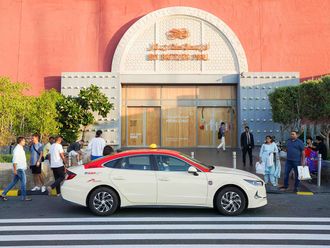More and more people are sending e-greetings. It's quick, easy and can be done at the last minute — never mind if it is less personal
Here it is, the New Year. And you didn't get around to sending out holiday cards, did you? Well, send season's e-card greetings!
"Internet cards are quick and easy and a good way to buzz someone,'' says District of Columbia resident Antonia Balazs, 36, who began sending her festive e-cards to friends three weeks back.
As a paid subscriber at American Greetings' electronic-card website, Balazs has unlimited access to thousands of e-cards for all occasions throughout the year. She regularly sends e-cards for birthdays and thank-you notes. And now that it's New Year, she's sending mostly e-cards — though her short list gets store-bought paper cards.
"A paper card requires more time and effort. It is more thoughtful,'' says Balazs. "Close friends and family get that thoughtfulness. Others might not. At least this way, I've followed through in some fashion.'' But holiday e-cards face uphill sledding against unyielding traditions this time of year.
According to the Washington-based Greeting Card Association, a trade group representing the $7.5 billion industry, more than 60 per cent of the seven billion cards sold each year will be Christmas cards. A GCA survey found that 92 per cent of consumers planned to purchase paper greeting cards this holiday season; 76 per cent said they would send out 20 or more.
"E-cards are another avenue or supplement, but they don't replace traditional paper cards,'' says GCA's executive director, Valerie Cooper.
"E-cards aren't quite as special as when someone takes the time to send you an individual card,'' she said.
According to Hallmark, during all of last year people sent 88 million free e-cards for various occasions from its online site — and 946,000 of those were a last-minute flurry on Christmas Eve.
"People aren't convinced they have the same desired effect,'' says Hallmark spokeswoman Deidre Parkes. "In all 73 per cent of people surveyed said they send holiday cards because they know how good it feels to receive them. That doesn't necessarily happen with e-card sending.''
E-cards don't stack up against paper cards for other reasons. Some recipients have slow online computer connections, which can make e-cards frustrating. And spam filters and virus worries are to e-cards what dogs are to postal carriers.
The biggest selling point for e-cards has been that they were free. But this year most e-card websites shifted to subscription services — $10 to $20 a year — cooling some users' interest, says Parkes. Hallmark.com still boasts a huge selection of free e-cards — including 70 free holiday e-cards, many of them animated action scenes with holiday music.
"Postage isn't getting any cheaper!'' says Jean Barto, a retired army reserve officer in Newport News, Virginia, who has sent 50 paper Christmas cards this year and, just last week, a dozen or so free e-cards. But she thinks the convenience argument for e-cards is overblown.
"When I send out the online cards, it takes nearly as long to do so as to write out and address a traditional card,'' says Barto.
But e-cards come in handy for people whose snail-mail addresses she can't find, she says. "There might be some people on my traditional card list that may migrate to the online list — if they fail to send me a card back this year.''
But e-cards' biggest obstacle is tradition. "People at Christmas are very traditional. Sending paper cards is a ritual steeped in that tradition,'' says Tina Benavides, executive director of card planning at American Greetings Corp.
People line their mantels with them, string them across doorways and hang them on their Christmas trees. "You could do that with (printed-out) e-cards but realistically you might not want to,'' says Benavides, who sends e-cards mostly to her dot-com friends. "I could never send my mother an e-card. But if you know someone who is into high-tech, then why not?''
And that's the niche approach e-card sellers are taking.
"Things are starting to really ramp up,'' says Sharon Schneider, senior vice-president and general manager for greetings at Bluemount.com, AmericanGreetings.com and e-greetings.com — all subscriber sites owned by American Greetings.
She says e-card sender demographics skew younger, more male and edgier than traditional greeting card buyers.
The most popular Christmas e-card last year at Americangreetings.com was "Santa Boogie'' — a cinematic Claymation-style e-card of a rotund St Nick rockin' out on a rooftop. "A lot of it truly is all about the recipient,'' she says. "You pick the product that meets your needs.''
© Los Angeles Times-Washington Post News Service
No more paper greeting cards?
Here it is, the New Year. And you didn't get around to sending out holiday cards, did you? Well, send season's e-card greetings!










